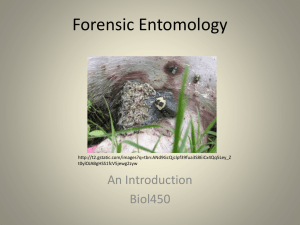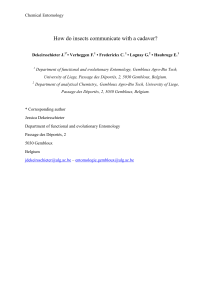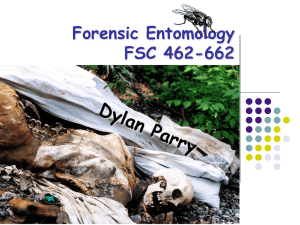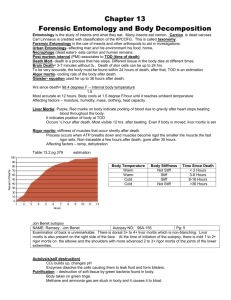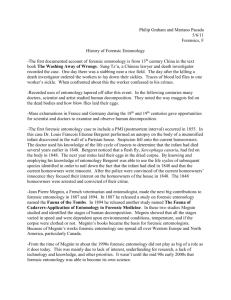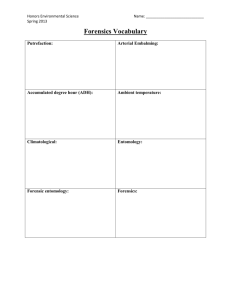Lecture 22
advertisement
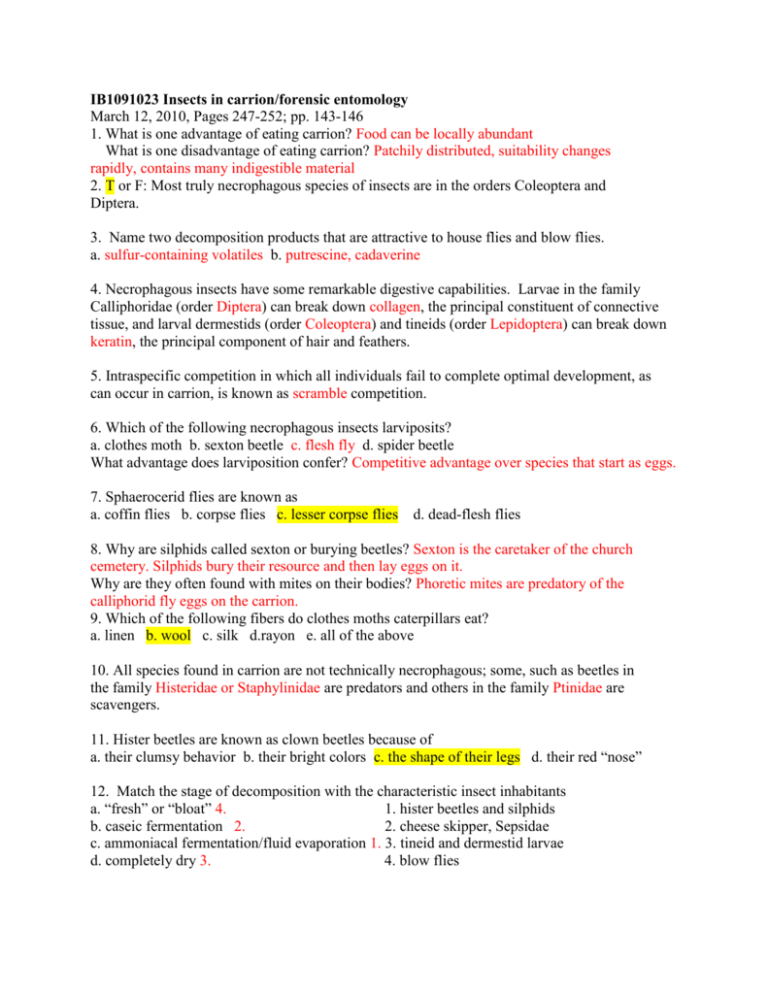
IB1091023 Insects in carrion/forensic entomology March 12, 2010, Pages 247-252; pp. 143-146 1. What is one advantage of eating carrion? Food can be locally abundant What is one disadvantage of eating carrion? Patchily distributed, suitability changes rapidly, contains many indigestible material 2. T or F: Most truly necrophagous species of insects are in the orders Coleoptera and Diptera. 3. Name two decomposition products that are attractive to house flies and blow flies. a. sulfur-containing volatiles b. putrescine, cadaverine 4. Necrophagous insects have some remarkable digestive capabilities. Larvae in the family Calliphoridae (order Diptera) can break down collagen, the principal constituent of connective tissue, and larval dermestids (order Coleoptera) and tineids (order Lepidoptera) can break down keratin, the principal component of hair and feathers. 5. Intraspecific competition in which all individuals fail to complete optimal development, as can occur in carrion, is known as scramble competition. 6. Which of the following necrophagous insects larviposits? a. clothes moth b. sexton beetle c. flesh fly d. spider beetle What advantage does larviposition confer? Competitive advantage over species that start as eggs. 7. Sphaerocerid flies are known as a. coffin flies b. corpse flies c. lesser corpse flies d. dead-flesh flies 8. Why are silphids called sexton or burying beetles? Sexton is the caretaker of the church cemetery. Silphids bury their resource and then lay eggs on it. Why are they often found with mites on their bodies? Phoretic mites are predatory of the calliphorid fly eggs on the carrion. 9. Which of the following fibers do clothes moths caterpillars eat? a. linen b. wool c. silk d.rayon e. all of the above 10. All species found in carrion are not technically necrophagous; some, such as beetles in the family Histeridae or Staphylinidae are predators and others in the family Ptinidae are scavengers. 11. Hister beetles are known as clown beetles because of a. their clumsy behavior b. their bright colors c. the shape of their legs d. their red “nose” 12. Match the stage of decomposition with the characteristic insect inhabitants a. “fresh” or “bloat” 4. 1. hister beetles and silphids b. caseic fermentation 2. 2. cheese skipper, Sepsidae c. ammoniacal fermentation/fluid evaporation 1. 3. tineid and dermestid larvae d. completely dry 3. 4. blow flies 13. When was the first account of forensic entomology written? Where did it take place? 1235 AD in China 14. Who was the author of “La Faune des Tombeaux”? Jean Pierre Megnin 15. An isomegalen diagram plots time from hatch to post-feeding against temperature; each line represents identical larval lengths at various temperatures. An isomorphen diagram plots time against temperature, with each line representing identical developmental stage 16. Provide two items that are typically reported on a forensic entomology data form. Death Scene area. Temperature 17. What effect does cocaine in a corpse have on the ability of a forensic entomologist to estimate post-mortem interval? Speeds up larval development (Shortens PMI) How about arsenic? Delays development (lengthens PMI) Malathion? Delays development (lengthens PMI) 18. Name two kinds of materials that can be identified in maggot bodies that can provide evidence of a crime: a. Barium from a gunshot wound. b. Drugs and poison 19. Provide 3 examples of forensic entomology that doesn’t involve estimation of postmortem interval. A Child neglect (lice, myiasis) B accidents (bee stings) C Lanlord/ tenant issues (house infestations) 20. How can DNA analysis be used in forensic entomology? DNA analysis can match insects to carrion resource. 21. What are two possible impacts of global climate change on forensic entomology? a.New faunal elements due to shifting ranges b. Changes in developmental period due to warmer temperatures 22. In what primetime television show is the character Gil Grissom a forensic entomologist? CSI And what kind of pet does he keep in his office? Cameroon Red Baboon tarantula 23. Name one real-life forensic entomologist Neal Haskell, David Faulkner, M.L. Goff
